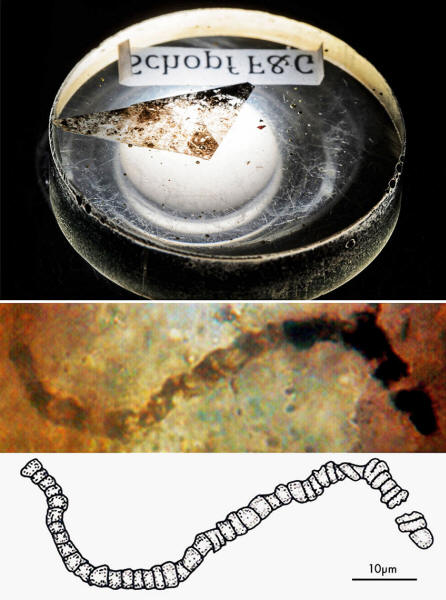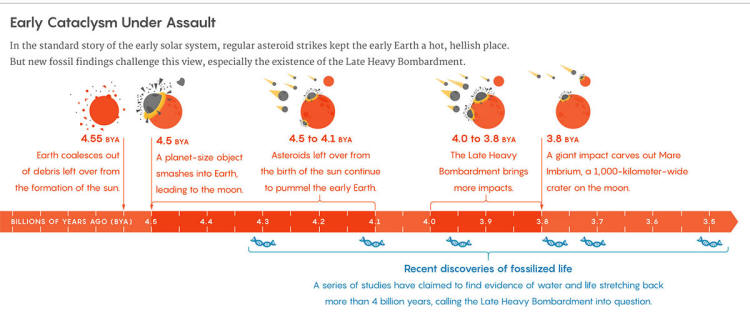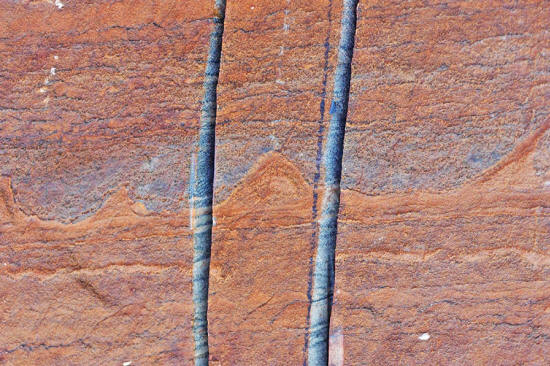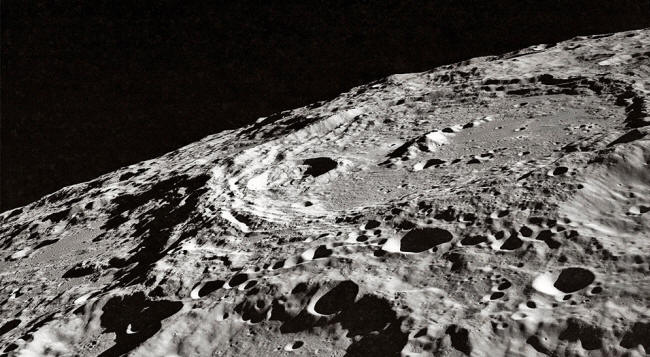|
from QuantaMagazine Website
Spanish
version might have looked during
the Late Heavy
Bombardment. suggests that life on Earth started earlier than anyone thought, calling into question a widely held theory of the solar system's beginnings.
Drive through the
northern outback for a while, south of Port Hedlund on the coast,
and you will come upon hills softened by time. They are part of a
region called the
Pilbara Craton, which formed about
3.5 billion years ago, when Earth was in its youth.
Within this rock, viewable only through a microscope, there are tiny tubes. Some look like petroglyphs depicting a tornado; others resemble flattened worms.
They are among the most
controversial rock samples ever collected on this planet, and they
might represent some of the oldest forms of life ever found.
If Valley and his team are right, the fossils imply that life diversified remarkably early in the planet's tumultuous youth.
The fossils add to a wave of discoveries that point to a new story of ancient Earth.
A sliver of a nearly 3.5-billion-year-old rock from the Apex Chert deposit in Western Australia (top). An example of one of the microfossils discovered
in a sample of rock
from the Apex Chert (bottom). Courtesy of J. William Schopf, UCLA (microfossil)
In the past year, separate teams of researchers have dug up, pulverized and laser-blasted pieces of rock that may contain life dating to 3.7, 3.95 and maybe even 4.28 billion years ago.
All of these microfossils - or the chemical evidence associated with them - are hotly debated. But they all cast doubt on the traditional tale.
As that story goes, in the half-billion years after it formed, Earth was hellish and hot. The infant world would have been rent by volcanism and bombarded by other planetary crumbs, making for an environment so horrible, and so inhospitable to life, that the geologic era is named the Hadean, for the Greek underworld.
Not until a particularly violent asteroid barrage ended some 3.8 billion years ago could life have evolved.
But this story is increasingly under fire.
Many geologists now think Earth may have been tepid and watery from the outset. The oldest rocks in the record suggest parts of the planet's crust had cooled and solidified by 4.4 billion years ago.
Oxygen in those ancient rocks suggest the planet had water (Oxygen-isotope Evidence from Ancient Zircons for Liquid Water at the Earth's Surface 4,300 Myr ago) as far back as 4.3 billion years ago.
And instead of an epochal, final bombardment, meteorite strikes might have slowly tapered off as the solar system settled into its current configuration.
Taken together, the latest evidence from the ancient Earth and from the moon is painting a picture of a very different Hadean Earth:
Ancient Clues
About 4.54 billion years ago, Earth was forming out of dust and rocks left over from the sun's birth.
Smaller solar leftovers continually pelted baby Earth, heating it up and endowing it with radioactive materials, which further warmed it from within. Oceans of magma covered Earth's surface.
Back then, Earth was not so much a rocky planet as an incandescent ball of lava. Not long after Earth coalesced, a wayward planet whacked into it with incredible force, possibly vaporizing Earth anew and forming the moon.
The meteorite strikes continued, some excavating craters 1,000 kilometers across.
In the standard paradigm of the Hadean eon, these strikes culminated in an assault dubbed the Late Heavy Bombardment, also known as the lunar cataclysm, in which asteroids emigrated to the inner solar system and pounded the rocky planets.
Throughout this early era, ending about 3.8 billion years ago, Earth was molten and couldn't support a crust of solid rock, let alone life.
Lucy Reading-Ikkanda Quanta Magazine
But starting around a decade ago, this story started to change, thanks largely to tiny crystals called zircons.
The gems, which are often about the size of the period at the end of this sentence, told of a cooler, wetter and maybe livable world as far back as 4.3 billion years ago.
In recent years, fossils in ancient rock bolstered the zircons' story of calmer climes. The tornadic microfossils of the Pilbara Craton are the latest example.
Today, the oldest evidence for possible life - which many scientists doubt or outright reject - is at least 3.77 billion years old and may be a stunningly ancient 4.28 billion years old.
In March 2017, Dominic Papineau, a geochemist at University College London, and his student Matthew Dodd described tube-like fossils in an outcrop in Quebec that dates to the basement of Earth's history.
The formation, called the Nuvvuagittuq (noo-voo-wog-it-tuck) Greenstone Belt, is a fragment of Earth's primitive ocean floor. The fossils, about half the width of a human hair and just half a millimeter long, were buried within.
They are made from an iron oxide called hematite and may be fossilized cities built by microbial communities up to 4.28 billion years ago, Dodd said.
The bright red rock in the Nuvvuagittuq Greenstone Belt appears to contain tube-shaped microfossils
dating to at least
3.77 billion years ago.
Similar structures exist in today's oceans, where communities of microbes and bloody-looking tube worms blossom around sunless, black-smoking chimneys.
Dodd found the tubes near graphite and with carbonate "rosettes," tiny carbon rings that contain organic materials.
The rosettes can form through varying non-biological processes, but Dodd also found a mineral called apatite, which he said is diagnostic of biological activity.
The researchers also analyzed the variants, or isotopes, of carbon within the graphite. Generally, living things like to use the more lightweight isotopes, so an abundance of carbon 12 over carbon 13 can be used to infer past biological activity.
The graphite near the rosettes also suggested the presence of life.
Taken together, the tubes and their surrounding chemistry suggest they are remnants of a microbial community that lived near a deep-ocean hydrothermal vent, Dodd said.
Geologists debate the exact age of the rock belt where they were found, but they agree it includes one of the oldest, if not the oldest, iron formations on Earth.
This suggests the fossils are that old, too - much older than anything found previously and much older than many scientists had thought possible.
The microfossils resemble
sea life that grows
near deep-sea hydrothermal vents.
Then in September 2017, researchers in Japan published (Early Trace of Life from 3.95 Billion Years Sedimentary Rocks in Labrador, Canada) an examination of graphite flakes from a 3.95-billion-year-old sedimentary rock called the Saglek Block in Labrador, Canada.
Yuji Sano and Tsuyoshi Komiya of the University of Tokyo argued their graphite's carbon-isotope ratio indicates it, too, was made by life.
But the graphite flakes were not accompanied by any feature that looked like a fossil; what's more, the history of the surrounding rock is murky, suggesting the carbon may be younger than it appears.
Farther to the east, in southwestern Greenland, another team had also found evidence of ancient life.
In August 2016, Allen Nutman of the University of Wollongong in Australia and colleagues reported finding stromatolites, fossil remains of microbes, from 3.7 billion years ago.
Allen Nutman prospecting for ancient microfossils
in the Isua belt in
southern Greenland.
Many geologists have been skeptical of each claim.
Nutman's fossils, for example, come from the Isua Belt in southern Greenland, home to the oldest known sedimentary rocks on Earth. But the Isua belt is tough to interpret.
Just as non-biological processes can form Dodd's carbon rosettes, basic chemistry can form plenty of layered structures without any help from life, suggesting they may not be stromatolites but lifeless pretenders.
In addition, both the Nuvvuagittuq Greenstone Belt and the Isua Belt have been heated and squished over billions of years, a process that melts and recrystallizes the rocks, morphing them from their original sedimentary state.
Regarding his work with the Pilbara Craton fossils, however, Valley is much less circumspect.
The stromatolites form small wavelike mounds in sedimentary rock.
The vertical lines
are cuts made by the researchers.
Signs of Life
The tornadic microfossils lay in the Pilbara Craton for 3.465 billion years before being separated from their natal rock, packed up in a box and shipped to California.
Paleobiologist William Schopf of UCLA published his discovery of the strange squiggles in 1993 and identified 11 distinct microbial taxa in the samples.
Critics said the forms could have been made in non-biological processes, and geologists have argued back and forth in the years since. Last year, Schopf sent a sample to Valley, who is an expert with a super-sensitive instrument for measuring isotope ratios called a secondary ion mass spectrometer.
Valley's team found that some of the apparent fossils had the same carbon-isotope ratio as modern photosynthetic bacteria.
Three other types of fossils had the same ratios as methane-eating or methane-producing microbes. Moreover, the isotope ratios correlate to specific species that had already been identified by Schopf.
The locations where these isotope ratios were measured corresponded to the shapes of the microfossils themselves, Valley said, adding they are the oldest samples that look like fossils both physically and chemically.
John Valley in his mass spectrometer laboratory
at the University of
Wisconsin, Madison.
While they are not the oldest samples in the record - supposing you accept the provenance of the rocks described by Dodd, Komiya and Nutman - Schopf's and Valley's cyclonic miniatures do have an important distinction:
The presence of so many different carbon isotope ratios suggests the rock represents a complex community of primitive organisms.
The life-forms must have had time to evolve into endless iterations. This means they must have originated even earlier than 3.465 billion years ago.
And that means our oldest ancestors are very, very old indeed.
Watery World
Fossils were not the first sign that early Earth might have been Edenic rather than hellish.
The rocks themselves started providing that evidence as far back as 2001. That year, John Valley found zircons that suggested the planet had a crust as far back as 4.4 billion years ago.
Zircons are crystalline minerals containing silicon, oxygen, zirconium and sometimes other elements. They form inside magma, and like some better-known carbon crystals, zircons are forever - they can outlast the rocks they form in and withstand eons of unspeakable pressure, erosion and deformation.
As a result, they are the only rocks left over from the Hadean, making them invaluable time capsules.
Valley chipped some out of Western Australia's Jack Hills and found oxygen isotopes that suggested the crystal formed from material that was altered by liquid water.
This suggested part of Earth's crust had cooled, solidified and harbored water at least 400 million years earlier than the earliest known sedimentary rocks.
If there was liquid water, there were likely entire oceans, Valley said.
Other zircons showed the same thing.
Zircons suggest there may even have been life.
In research published in 2015, Elizabeth Bell and her coauthors presented evidence for graphite embedded within a tiny, 4.1-billion-year-old zircon crystal from the same Jack Hills.
The graphite's blend of carbon isotopes hints at biological origins, although the finding is - once again - hotly debated.
An X-ray of a 4.1-billion-year-old sample of zircon
reveals dark spots
made by carbon deposits. (Department of Earth, Energy, and Environmental Sciences, Stanford University, Stanford, CA)
If the signals in the ancient rocks are true, they are telling us that life was everywhere, always...
In almost every place scientists look, they are finding evidence of life and its chemistry, whether it is in the form of fossils themselves or the remnants of life's long-ago stirrings.
Far from fussy and delicate, life may have taken hold in the worst conditions imaginable.
Or maybe not...
Maybe Earth was just fine. Maybe those impacts weren't quite as rapid-fire as everyone thought.
Evidence for a Beating
We know Earth, and everything else, was bombarded by asteroids in the past.
The Moon, Mars, Venus and Mercury all bear witness to this primordial pummeling. The question is when, and for how long.
Based largely on Apollo samples toted home by moon-walking astronauts, scientists came to believe that in the Earth's Hadean age, there were at least two distinct epochs of solar system billiards.
As with most things in geochemistry, evidence for a world-rending blitz, an event on the hugest scales imaginable, is derived from the very, very small.
Isotopes of potassium and argon in Apollo samples suggested bits of the moon suddenly melted some 500 million years after it formed. This was taken as evidence that it was blasted within an inch of its life.
Zircons also provide tentative physical evidence of a late-era hell-escape. Some zircons do contain "shocked" minerals, evidence for extreme heat and pressure that can be indicative of something horrendous.
Many are younger than 3 billion years, but Bell found one zircon suggesting rapid, extreme heating around 3.9 billion years ago - a possible signature of the Late Heavy Bombardment.
So far, there are no other signs, said Aaron Cavosie of Curtin University in Australia.
Craters on the moon have been taken as evidence for the Late Heavy Bombardment, but reassessments of the geological evidence from Apollo moon rocks casts doubt on whether the asteroid bombardments
during the Hadean era
were as severe as was thought.
Moon Rocks
In 2016 Patrick Boehnke, now at the University of Chicago, took another look at those original Apollo samples, which for decades have been the main evidence in favor of the Late Heavy Bombardment.
He and UCLA's Mark Harrison reanalyzed the argon isotopes and concluded that the Apollo rocks may have been walloped many times since they crystallized from the natal moon, which could make the rocks seem younger than they really are.
There's a chance that astronauts from the six Apollo missions sampled rocks from a single asteroid strike whose ejecta spread throughout the Earth-facing side of our satellite.
In addition, moon-orbiting probes like the Gravity Recovery and Interior Laboratory (GRAIL) spacecraft and the Lunar Reconnaissance Orbiter (LRO) have found around 100 previously unknown craters, including a spike in impacts as early as 4.3 billion years ago.
Bill Bottke, who studies asteroids and solar system dynamics, is one of several researchers coming up with modified explanations.
He now favors a slow uptick in bombardment, followed by a gradual decline.
Others think there was no late bombardment, and instead the craters on the moon and other rocky bodies are remnants from the first type of billiards, the natural process of planet building.
Life Takes Hold
While it plays out, scientists will be debating much bigger questions than early solar-system dynamics. If some of the new evidence truly represents impressions of primeval life, then our ancestors may be much older than we thought.
Life might have arisen the moment the planet was amenable to it - the moment it cooled enough to hold liquid water.
If there was no mass sterilization at 3.9 billion years ago, or if a few massive asteroid strikes confined the destruction to a single hemisphere, then Earth's oldest ancestors may have been here from the haziest days of the planet's own birth.
And that, in turn, makes the notion of life elsewhere in the cosmos seem less implausible. Life might be able to withstand horrendous conditions much more readily than we thought.
It might not need much time at all to take hold. It might arise early and often and may pepper the universe yet.
Its endless forms, from tubemaking microbes to hunkering slime, may be too small or simple to communicate the way life does on Earth - but they would be no less real and no less alive.
|











